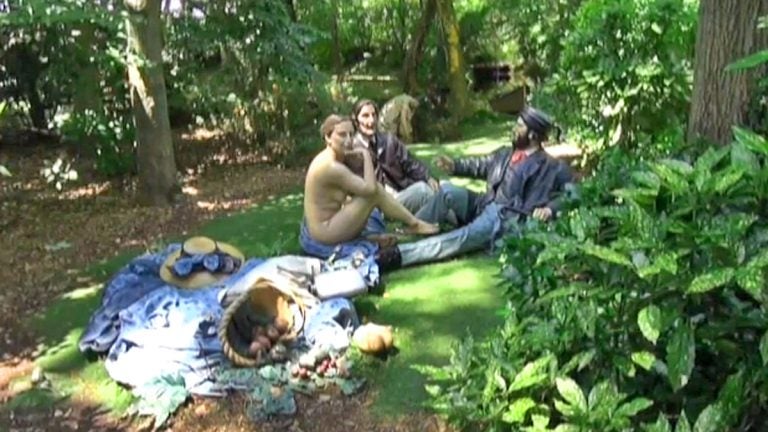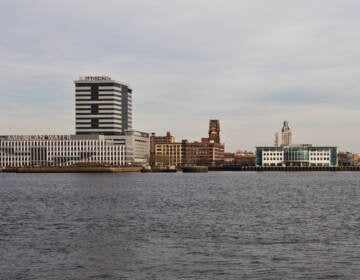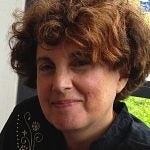How the fairgrounds was transformed into Grounds for Sculpture

Pass through the topiary archway into Grounds For Sculpture, and you enter a world of illusion. Inside the 42-acre sculpture park in Hamilton, N.J., founded by sculptor and pharmaceutical heir J. Seward Johnson Jr. 25 years ago, you forget the industrial/suburban surroundings. Visitors become mesmerized by the oasis of willows and ponds, hillocks and wildflower meadows, that create a sublime setting for works in stone, steel and bronze.
The man behind the curtains, creating this illusion, is Bruce Daniels, whose official title is Facilities Director/Project Manager. From an office on the second floor of the Motor Exhibit Building, Daniels also serves as archivist – he’s been here since the founding and has seen it develop first hand. Rather, his hand is one that helped develop it.
In 1984, Johnson invited Daniels to take a look at the former state fairgrounds property to stabilize and secure it. “I was aghast! The place was a wreck. It was overgrown, it had been abandoned for years. The grass was thigh-high, the roofs were leaking, there were pigeons living inside, and people had come with crowbars and removed the ornamental terra cotta. I was not enthusiastic about the plan for a sculpture park.”
Today, Daniels sees trees, once small, grown to be enormous. “We started with 12 trees. Sugar and Norway Maples that had been part of the Fairgrounds were damaged from people trampling their root systems.
“The soil was horrible,” he continues. “We had to bring in hundreds of trucks of compost and till it in to the compacted ground. There were no water features. We would dig holes in the ground and then pile it up somewhere else to create a hill.”
Over the years, thousands of trees and tens of thousands of shrubs have been planted. “It’s been rewarding to see it grow from a flat brown ruin to what it is today.”
Daniels is well aware that if he and his crew (three staffers and outside contractors) stop work, the site will return to a jungle of weeds and vines. “Nature will take over rapidly if you turn your back. Birds will seed trees where you don’t want them.”
Daniels recalls the installation of one of the park’s most noteworthy sculptures, Dejeuner Déjà vu, based on the Edouard Manet painting Dejeuner Sur L’Herbe (Luncheon on the Grass), in which a naked woman sits with two men fully clothed in black. Another woman is in the distance, stooping in a pond near a rowboat.
To create the setting for the tableau on a site that was previously lawn, Daniels had to go to a tree broker to truck in maples and sycamores large enough to look like those in the painting. Even though the specimens were fully mature, he had to lean them in the directions they lean in the painting. They had to dig a pond to create the water feature and hill. A concrete foundation for the bronzes, fabricated at the Atelier, was built. Plywood cutouts of the figures were used to line everything up.
“A boat builder was hired to replicate the rowboat in the painting,” Daniels recounts. “Many dozens of perimeter screening trees were planted, as were hundreds of understory saplings and shrubs as we attempted to recreate the colors and textures of Manet’s woodland.”
When it was all complete, Johnson hired a photographer to match it to the painting. “Some of the figures’ body parts didn’t relate to each other properly; the waterfall wasn’t quite the right height; and one of the most prominent trees didn’t have enough lean over the stream. We were ordered back in.” The waterfall had to be rebuilt, a tree re-cabled to lean properly, and a new foundation for the bronzes had to be installed. “It drove me crazy,” admits Daniels.
Today, people arrive at the park and ask “Where are the naked people picnicking?”
“You have to look for it,” says Daniels, of the labor of love that is subtly obscured by bushes. “Seward wanted it to be a surprise.”
When the park first opened in 1992, it was by appointment only. Admission was free, and there was no place to eat. “Now it’s vastly different – we charge $15 per visit, and have to close the gate because the facility gets overwhelmed.
There are so many more people working here – in admissions, curatorial, education, events, food service – the sheer amount of public use adds up to wear and tear, from setting off the fire alarm to a freezer going down, it all comes back to the property department. We get a couple more thousand on the weekends and we’re dealing with bathroom supplies. We have to stay on top of all these things so people have a good experience here.”
________________________________________
The Artful Blogger is written by Ilene Dube and offers a look inside the art world of the greater Princeton area. Ilene Dube is an award-winning arts writer and editor, as well as an artist, curator and activist for the arts.
WHYY is your source for fact-based, in-depth journalism and information. As a nonprofit organization, we rely on financial support from readers like you. Please give today.





